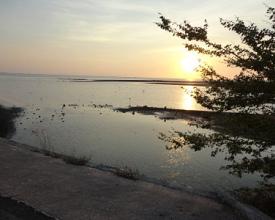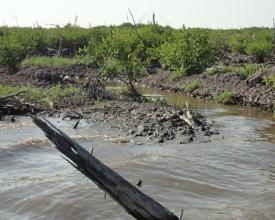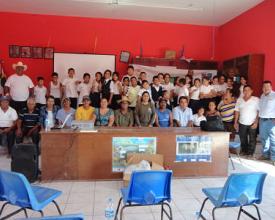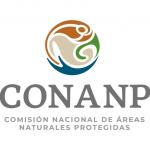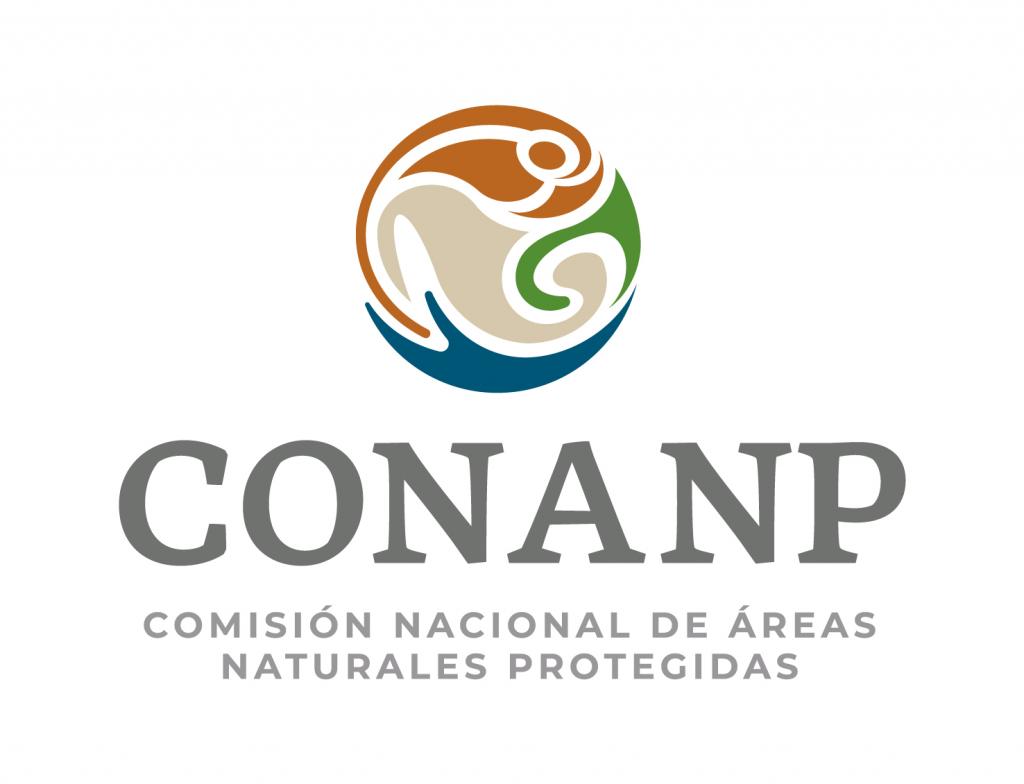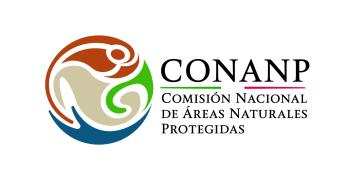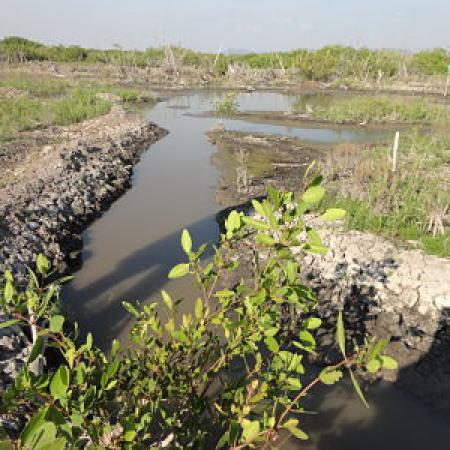
Changing Climate Patterns, Changing Flows, Changing Minds: restoration of mangroves and hydrological flows
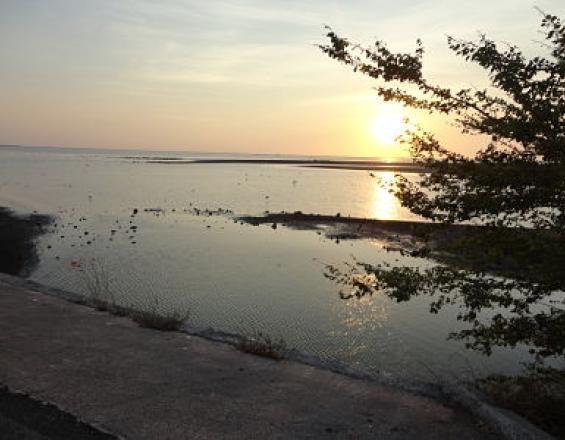
When Marismas Nacionales, Nayarit, Mexico, was declared a biosphere reserve, there was community resistance to change of their current productive practices. CONANP developed a long-term strategy for changing perception of the context of climate change impacts, that was focused on raising awareness, capacity development, and continual technical support. A specific measure has been the rehabilitation of mangrove ecosystems through the reestablishment of natural salt and fresh water flows.
Context
Challenges addressed
Environmental:
Tropical storms damage shrimp farms, mangrove systems and channels, which, combined with a loss of water flow in the rivers entering the estuary (because of agricultural use and less rainfall), is causing an increase in mangroves' salinity, damaging the socio-ecosystem.
Socio-economic:
The underpricing of fish by the fishing communities results in the inability of the latter to cover costs and livelihood needs. This can result in over-fishing to make up for the gap.
Location
Process
Summary of the process
At the core of the solution in Marismas Nacionales, Nayarit Biosphere Reserve is the institutional flexibility (building block IV) necessary for CONANP to be able to take into account evidence from the field, as well as fieldworkers and local community knowledge and opinions, in order to adapt its policies to create a sustainable agreement on ecosystem rehabilitation and local livelihood maintenance that is relevant to the people and ecosystems (building blocks I, II and III). This institutional flexibility, along with partnerships with the community in terms of long term support and mentoring, enables the community to positively change its mind and attitude with respect to its sense of belonging to the reserve (building block I), thus creating an environment in which innovative practices can be adopted by the community (building block V). A change of mind (building block I) and correct timing of payments for supporting mangrove rehabilitation (building block III) directly support the creation of an eager local workforce for mangrove rehabilitation (building block II).
Building Blocks
Transforming perceptions on ecosystem-livelihood connection
Local communities have not always welcomed, in every case, the creation of new protected areas. It is important to raise awareness among local communities about the connection between ecosystems conservation and local livelihoods. To do so, the authorities need to be able to create a sense of identity and belonging towards the protected ecosystems, rather than a sense of exclusion. The solution in Marismas Nacionales, Nayarit Biosphere Reserve is a long-term effort with intensive community support and mentoring by CONANP fieldworkers. The strategy has been focused on changing perceptions of the community. This approach has had the additional effect of influencing the institutions that govern the protected area, generating a better shared understanding of effective and sustainable support for both mangrove rehabilitation and local livelihoods. In this way, the community and CONANP´s staff have joined forces to ensure that local needs are met by rehabilitating the mangroves from a more territorially, and livelihood, coherent perspective, rather than an administrative one. Changed perceptions have become a more important driver of positive community action than just payments for ecosystem services or subsidies.
Enabling factors
a) Existing cooperatives to lead change processes on behalf of communities;
b) capacity to monitor benefits from diverse initiatives;
c) good management of the NGO network and permanent presence of field workers for capacity development;
d) financial resources to nurture fishermen’s organizational capabilities up to the point where they are self-organized;
e) open-minded government authorities.
Lesson learned
a) An important factor in changing minds of local communities is the involvement of women and children in awareness raising, planning and negotiation activities;
b) creating alternatives for migrating from the reserve helps to underscore the importance of maintaining local ecosystems;
c) being able to demonstrate quick and tangible benefits as a result of ecosystem maintenance or through the introduction of sustainable practices helps enormously to convince communities. Strengthening sustainable fishing practices can provide this type of quick results.
Using natural processes in mangrove rehabilitation
When the goals of mangrove rehabilitation are subordinated to those of climate change mitigation and the creation of carbon sinks, a project can easily fall into the trap of equating effective rehabilitation with simple reforestation. It is important to consider that clear and well-maintained channels allow hydrological flows between salt and freshwater sources in a mangrove. This enables the ecosystem to find a natural balance that favours biodiversity. It also allows the movement of fish to and from the ecosystem in tune with the water flows, and facilitate the natural expansion of the mangroves via greater seed dispersal. Improving hydrological flows may include the removal of mangrove trees in key places, or the absence of them in others. In Marismas Nacionales, the rehabilitation project went through a steep learning curve that included waste of time and resources, resulting from a traditional approach of reforestation, involving raising, planting and caring for seedlings. After 2-3 years, the policy was changed to one of creating and maintaining channels and flows between the lagoons in the reserve, and thus encouraging a natural system's rehabilitation.
Enabling factors
a) A committed local community workforce who is convinced of the benefits of rehabilitating the mangroves, and does not do it just for the payment;
b) highly trained fieldworkers, with scientific knowledge, who can guide the effective rehabilitation of mangroves, and quickly modify their approach if needed;
c) a sustainable, intelligently targeted public programme of payments for local communities;
d) understanding the pressures and root causes of the mangrove system’s problems.
Lesson learned
a) Without good technical, scientific guidance it is not possible to rehabilitate mangrove ecosystems in a manner that is sustainable, or sustainable for local livelihoods.
b) When goals of mangrove rehabilitation are subordinated to those of climate change mitigation (carbon sink creation), it can be easy to confuse good rehabilitation with simply increasing the number of trees.
c) Creating and maintaining channels within the mangrove system in order to facilitate natural flows between salt and freshwater sources is a key component for reducing salinization problems, as well as for maintaining mangrove's health.
d) Problems for mangrove systems can be exacerbated by climate events such as tropical storms that destroy parts of the mangroves. However, chronic problems can be caused by upstream activities, such as a reduction in river flows due to water over-extraction for agricultural purposes. This increases the salinity problems of the mangrove systems.
Integrating payment programmes into a larger strategy to promote sustainable livelihoods and long-term ecosystem conservation
Mangrove rehabilitation activities require significant investments of time and effort by local communities. Affording these investments might not be feasible for local communities who are usually involved in traditional activities to guarantee their livelihoods. By trying to understand the local dynamics, CONANP could coordinate its intervention: it was able to time its federally funded programme of payments for the fishermen in a manner that was compatible with local productive activities. CONANP designed a payment schedule that would pay local workers for their labour in mangrove rehabilitation and was also complementary to current traditional activities. This analysis prevented time overlaps, and any conflict or negative side-effect that could be derived from the payments scheme. In this case, the rehabilitation work and payments were set for the end of the shrimp fishing season, with the result that the local communities did not have to unnecessarily divide their time between various activities. This enabled local community members to maintain their income during the shrimp fishing season and earn an additional income from mangrove rehabilitation off-season.
Enabling factors
a) Economic and human resources to be able to employ local people to carry out rehabilitation works;
b) use of local knowledge and fieldworkers’ expertise to understand working rhythms;
c) flexibility to adapt payment schemes according to local productive activities.
Lesson learned
Payment schemes for environmental rehabilitation activities can be more successful when they take into account:
a) the fact that the ability to maintain a regular income source throughout the year is an important adaptive capacity for local communities;
b) that time is limited for local communities, and there will be more community engagement if rehabilitation activities do not collide with principle productive activities;
c) that such payment systems may not be sustainable in the long term (government budgets can fall; policies can change), so they should be subordinated to activities that generate a drive within the community for maintaining the ecosystems as a normal part of preserving their livelihoods.
Using a flexible approach for defining conservation and production areas based on local knowledge
A distinctive characteristic of this reserve is that almost the whole of its territory is under either community, “ejidal”, or private ownership rather than federal control. CONANP had to take a different approach when working with communities on climate change adaptation issues; CONANP decided to work with an ecosystem-based perspective. This approach has required the flexible interpretation of federal regulations and institutions governing conservation and climate change mitigation policies. At the core of this flexibility has been the rejection of a strictly administrative polygon approach to define large conservation areas in which no productive activities can take place in the mangrove ecosystems. Open discussions and negotiations with the local communities have resulted in CONANP taking a flexible approach, which has used local knowledge to identify an ecosystem, and livelihood, relevant division of the mangroves into areas designated for pure conservation and for sustainable productive activities. Maintaining sustainable productive activities in the mangrove systems supports the long-term goal of changing community attitudes towards maintaining the mangrove systems as an integral component of community livelihoods.
Enabling factors
1. Intensive dialogue & negotiation (before and after the establishment of the reserve) with local communities.
2. Listening and accepting the validity of local communities’ and field workers’ views when designing policies.
3. Willingness to change institutional regulations & approaches to accommodate diverse points of view and local knowledge.
4. A capacity to monitor the effectiveness of planned measures, and to be able to recognize when plans need to be changed with local community support.
Lesson learned
1) It soon became clear that designating a conservation area solely based on an administratively pre-defined polygon was not going to come out as a successful conservation and management strategy, because the polygon: a) was not encompassing correctly the ecosystems and their connectivity; b) excluded the possibility of communities for generating a sense of belonging to the reserve, without which joint responsibility for its conservation cannot be possible.
2) Conservation and livelihoods are two sides of the same coin. In ecosystems in which communities live, you cannot have one without the other.
3) A balance between conservation and livelihoods was achieved through negotiation and open-mindedness on both sides: a smaller conservation area was accepted in return for stricter controls, and greater fisherman-led effort for maintaining a sustainable approach to productive activities in the rest of the reserve.
Adoption of innovative technology
In order to sustain their productive activities in the face of climate change and economic uncertainties, oyster farmers quickly adopted an innovative technology: new platforms for oysters’ growth. The characteristics of these platforms are that: a) they are more durable than the traditional ones, increasing the lifetime from 3 years to up to 25; b) they replace the use of local mangrove trees by synthetic materials; c) since they move up and down with the tide and water levels, they are more resistant to hydrological events.
Enabling factors
- CONANP set up a forum for exchange of innovative ideas between oyster producers;
- evidence that the new platforms work in the field;
- the capacity for local producers to associate and gather the required resources to pay for the new type of platforms;
- awareness of climate change impacts.
Lesson learned
The major lesson learnt was that working with the existing cooperatives can produce a powerful ally for conservation; in this case, it made possible the adoption of new techniques and regulations in the existing productive activities. It also made clear that it is possible to produce enough economic revenues for all members of the cooperative and, at the same time, preserve the surrounding natural resources. The oyster cooperative has been spreading a collective vision for sustainable management and use of natural resources in the Camichin area, a task that CONANP would not be able to perform by itself due to lack of staff and budget.
Impacts
Environmental:
Inner lagoon mangrove ecosystems have experienced an unprecedented rehabilitation. Rather than an indiscriminate replanting of mangroves, biodiversity is benefiting from a strategic rehabilitation of mangroves through the reestablishment of natural salt and fresh water flows, via effective channel management. This is leading to a reduction in salinity and an increase in nutrient exchange. As a result, the local shrimp industry has seen positive impacts on its productivity.
Social:
CONANP and local communities are effectively collaborating to generate mutual benefits for ecosystems and livelihoods. Local communities and authorities have benefited from improved knowledge and collaboration, linking sustainable ecosystems and livelihoods.
Economic:
The local oyster industry, closer to the estuarine zone, has implemented innovative adjustments in their practices and benefited from increased sources of income, reducing long-term costs and maintaining productivity. Local fishing cooperatives are rethinking to price their products above their real costs and their livelihood needs. In spite of the pressure to sell their products at low prices, through intermediaries, CONANP is focusing on strengthening price setting capacities to reduce economic pressure.
Beneficiaries
- Local fishing communities and authorities.
- Local oyster industry.
Sustainable Development Goals
Story

Marismas Nacionales Biosphere Reserve is one of the youngest protected areas in Mexico (established in 2010). Most of its territory is under either communitarian, “ejidal”, or private ownership, rather than federal control. This has compelled CONANP to take a different approach when working with communities in order to adapt to climate change from an ecosystem-based perspective. The reserve and its communities are under threat from hurricanes, phenomena that cause losses of mangrove ecosystems and fish nurseries. It also suffers of changes in rainfall patterns, which cause economic losses in productive activities such as oyster and shrimp production, and agriculture. These threats are increased due to climate change, making the reserve more vulnerable. When the reserve was established, there was a lot of community opposition to make changes on its productive practices. CONANP embarked on a long-term strategy for influencing local perception by awareness raising, capacity development and continuous technical and moral support, rather than solely on financial support linked to payments for ecosystem services or subsidies. The intention was that communities would change because they believed in the ecological and long-term value of livelihoods and their work, not just because they were paid for it. CONANP has provided more opportunities for the local communities by implementing flexible policies about the use of mangroves. This has allowed the community to adopt a range of secondary productive activities based on the sustainable use of the mangrove ecosystems, which function as buffers when climate threats affect fisheries. This has also led to a reduction in conflicts and a greater community appreciation of the value of the ecosystems in which they live. As a result, local fishing communities have been responsible, with CONANP’s support, for rehabilitating local mangroves, leading to a win-win for both biodiversity and livelihoods.

